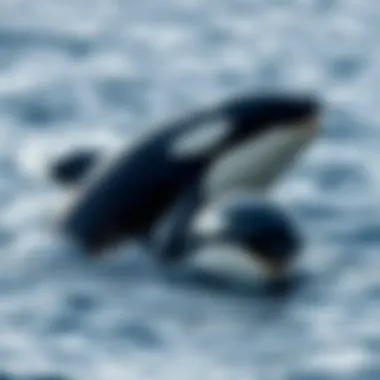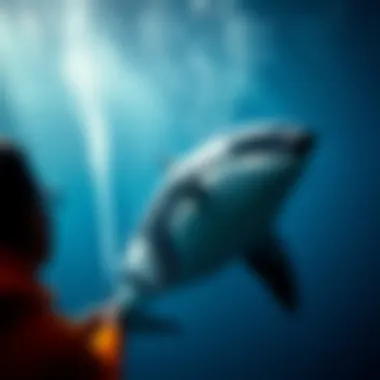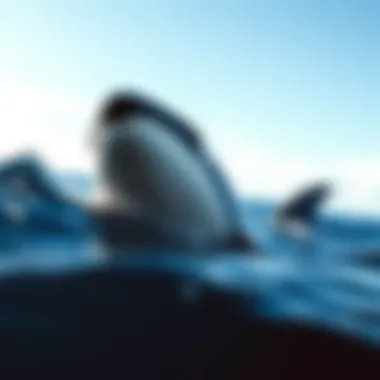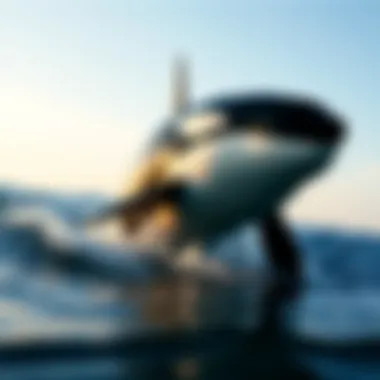Understanding the Term 'Killer Whale' and Its Origins


Intro
Killer whales, known scientifically as Orcinus orca, have often been the subject of fascination and misunderstanding. The term 'killer whale' can evoke images of ferocious predators, yet there's much more to these creatures than what their name might suggest. This article aims to dissect the origins of the term, reveal the deeper cultural narratives it carries, and highlight the ecological significance of these marine mammals.
Language has a profound influence on how we perceive the world around us. For killer whales, the interplay of terminology and public perception plays a significant role in their identity. Some might view them as fearsome ocean hunters, while others recognize them as social, intelligent beings essential to marine ecosystems. Understanding the etymology and implications of the name 'killer whale' allows us to appreciate the complexity of these animals and their vital role in the ocean.
In this exploration, we will uncover the historical context, delve into linguistic nuances, and examine how such terminology shapes our understanding of killer whales. The discussion will guide us through different angles—from myths and legends to modern scientific insights—illustrating the multifaceted relationship humans share with these striking creatures.
Before embarking on this journey through language and ecology, it is important to clarify what exactly we aim to achieve with this narrative. We’ll dissect key points, discuss cultural beliefs tied to killer whales, and unveil considerations of the term's ecological implications. Thus, let’s plunge straight into the depths of this fascinating terminology.
Prelude to Orcinus orca
Understanding the species Orcinus orca, commonly known as killer whales, is crucial to our appreciation of marine ecosystems. These creatures are not just fascinating members of the ocean; they also hold significant ecological and cultural importance. By digging into their taxonomy, social structures, and natural behaviors, we unveil layers of complexity that enrich our understanding of these marine mammals.
Recognizing the importance of killer whales allows us to connect deeply with the ocean's dynamics. Their role as apex predators—sitting at the top of the food chain—indicates their significant influence over the populations of other marine creatures. This makes them a keystone species, vital for maintaining ecological balance, which highlights their importance in conversations around conservation efforts.
The vast waters where killer whales roam are filled with misunderstandings and misconceptions. Discussions around Orcinus orca not only reveal their biological characteristics but also compel us to confront the narratives that have shaped societal perceptions. By examining what lies beneath the surface, we begin to appreciate their historical context and cultural significance.
General Overview
Killer whales are particularly interesting due to their complex social structures and diverse hunting techniques. They are often found in pods, social groups that can range from a few individuals to over 40 members. These pods are typically matrilineal, meaning they are led by maternal figures and often consist of closely related females and their offspring. This unique social characteristic allows killer whales to share knowledge, improving efficiency in hunting and nurturing strategies.
They inhabit oceans worldwide, from tropical to polar regions, showcasing a remarkable adaptability that adds to their mystique. Despite the wide distribution, they are often subject to intensive human scrutiny. The reflective nature of their social interactions invites comparisons with human societies, shedding light on how social networks may influence intelligence and behavior.
Taxonomy and Classification
When diving into the taxonomy of Orcinus orca, it is worth noting that they belong to the family Delphinidae, which includes various species of dolphins. What sets killer whales apart is their size and distinctive coloring—typically a striking black-and-white pattern that allows for easy identification. Their classification within the scientific community goes as follows:
- Kingdom: Animalia
- Phylum: Chordata
- Class: Mammalia
- Order: Cetacea
- Family: Delphinidae
- Genus: Orcinus
- Species: Orcinus orca
This structured classification indicates their relation to other marine mammals and enhances our understanding of evolutionary paths. A closer examination reveals that they are not merely a singular species but are categorized into various ecotypes that exhibit distinct behaviors, dietary preferences, and habitats. For instance, resident killer whales often feed on fish, while transient pods might hunt seals or even larger whales.
Overall, diving into the intricate world of Orcinus orca sets the stage for a broader discussion about the terminology that has emerged around these fascinating beings. It invites us to reflect not only on what we know but also on how our language shapes our understanding and perception of the natural world, making it all the more essential as we move forward in our exploration of this topic.
Etymology of 'Killer Whale'
Understanding the term "killer whale" is not just a linguistic endeavor; it opens a window into how language shapes perception and influences our relationship with the natural world. The etymology of this term carries with it historical connotations, cultural interpretations, and even misconceptions that impact conservation efforts today. By examining its roots, we can comprehend the broader implications of naming and how that affects public understanding of the majestic creatures known as Orcinus orca.


Historical Origins
The phrase "killer whale" derives from the Spanish term "asesina ballena," which translates to "whale killer." This terminology initially arose from the observation of these orcas as formidable predators of larger whale species. Early sailors and fishermen, generally unfamiliar with marine biology, characterized them based on their actions, ascribing a deadly reputation that painted orcas in a particularly fearsome light.
This historical context is crucial. The label did not arise from a place of malice; rather, it stemmed from human attempts to categorize and understand the behaviors witnessed in the wild. However, this often superficial interpretation failed to capture the complexity of orca behavior and the role they play in marine ecosystems. From Pod-1 to Pod-2, the cardiovascular relationships among pods exhibit linking dynamics that metrics such as aggression merely overlook. What many failed to understand was that killer whales have a highly developed social structure and an impressive intelligence, often exhibiting cooperative hunting strategies and family bonds.
Linguistic Development
Diving into the linguistic progression reveals how the term evolved. Over the years, translations and adaptations took place across various languages. While "killer whale" has become the common English name, in other cultures, orcas are sometimes referred to as "blackfish" or "grampus," highlighting different facets of their identity.
Additionally, the way we use language tends to shift with changing societal values. In recent years, there has been a push toward more respectful terminology, reflecting a deeper understanding of the species. More scientifically accurate names, like Orcinus orca, are being favored in academic circles, as they signify a commitment to viewing these creatures as part of the ecosystem rather than just as ruthless predators. The change in language underscores a gradual maturation in environmental consciousness, moving towards a view that appreciates these animals' roles in biodiversity and their complex intra-species interactions.
"Language can inspire action, and choosing our words carefully about killer whales can foster respect for their ecological significance."
In summary, the etymology of the term killer whale encompasses shifts influenced by historical usage and societal understanding. Moving forward, the challenge remains to balance these linguistic heritages with our evolving knowledge, fostering an informed dialogue about the remarkable Orcinus orca.
The Role of Cultural Perceptions
Cultural perceptions shape our understanding of various subjects, and the killer whale is no exception. The term "killer whale" carries with it a weight that influences not only how we view these creatures but also how conservation efforts are approached. In essence, cultural narratives contribute to a dualistic perception of killer whales: one that is rooted in fear and another that recognizes their majestic nature.
Cultural beliefs surrounding killer whales often stem from historical interpretations and local myths. Their significant presence in marine ecosystems doesn't escape the attention of folklore, further painting them in a light that reflects both admiration and caution. For many coastal communities, killer whales are seen as protectors of the sea, revered figures that demand respect. However, this respect is often tainted with apprehension, stemming from the etymology of their name, which suggests ferocity.
Being called a "killer" evokes strong images, which can warp public understanding. Is the name a reflection of their true nature? The discussion underscores how cultural narratives impact not just perception but also conservation efforts. If the dominant view remains one of aggression concerning these animals, support for initiatives aimed at their protection can wane. It’s essential for advocates to strive for a shift in narrative, emphasizing their role in the ecosystem rather than focusing solely on their predatory capabilities.
The interplay between culture and perception reveals that there is much at stake when it comes to our understanding of orca behavior and ecology. Visibility in our cultural media often influences public belief, which can catalyze or hinder important conservation initiatives. This perspective is crucial as we progress toward an enhanced appreciation of these mammals.
Killer Whales in Folklore
In various indigenous cultures, killer whales are depicted as powerful beings carrying specific lessons and morals. Stories often illustrate their profound connection to human life, highlighting them as symbols of strength and unity. For instance, among the Coast Salish people of the Pacific Northwest, the killer whale (Orcinus orca) is linked to the idea of family and community. The narratives tell of orcas assisting lost sailors, bringing them to safety.
Conversely, some tales present them as angry spirits, demanding respect and caution from those who dare disrupt their domain. These contrasting tales reflect a nuanced understanding and respect of these marine mammals, perhaps offering an allegory relevant to life: embracing fear while recognizing the potential for beauty and learning.
Impact of Media Representation
The media plays a pivotal role in molding public perceptions of killer whales. Documentaries, films, and print media have the power to disseminate information widely. Unfortunately, the portrayal is frequently skewed towards sensationalism, focusing on the creature's hunting prowess or aggressive behavior rather than ecological significance.
Consider the impact of shows like "Blackfish," which spotlighted the effects of captivity on killer whales. Such narratives can foster empathy and a call to action, yet they can also reinforce existing fears. The risk remains that repeated emphasis on violence may overshadow the intelligence and societal structures inherent in orca communities.
Awareness around the multifaceted nature of these creatures is essential. Content creators could present balanced views that feature both the extraordinary attributes of killer whales and their ecological roles. Highlighting their social structures, communication skills, and emotional capabilities can counteract the fear-mongering that often pervades.


In summary, cultural perceptions shape our connection to killer whales in profound ways, influencing everything from conservation efforts to individual experiences. The narratives we embrace, from both folklore and media, define how we interact with the natural world, impacting both killer whales and the ecosystems they inhabit.
Connotations of the Term
In the exploration of killer whales, also known as Orcinus orca, the term itself carries significant weight in both conservation and public understanding. The connotations of the term "killer whale" are multifaceted, shaping perceptions that can have profound ecological implications and affecting conservation efforts. This term, originating from a misinterpretation of their hunting prowess, has implications that reach beyond mere nomenclature, affecting how we interact with and protect these majestic creatures in their natural habitats.
Implications for Conservation Efforts
The term "killer" in killer whale often conjures images of aggression and danger, potentially deterring people from supporting their conservation. This widely held perception may lead to a misunderstanding of the species, painting them as ruthless predators rather than intelligent social creatures. As conservationists strive to protect under-threated habitats and promote awareness of marine ecosystems, this grim label can prove more hindrance than help.
For years, organizations have worked tirelessly to reframe public perceptions surrounding killer whales in an effort to garner support for their protection. More positive narratives highlight their complex social structures and intelligence, which may do more to engage the public rather than further entrenched stereotypes. This is crucial, especially since funding and advocacy often hinge on public sentiment. When people understand that killer whales play vital roles in maintaining marine health, they are inclined to become active participants in conservation efforts.
- Investing in Education: Programs aimed at educating the community about the crucial roles of these marine mammals could reshuffle the narrative.
- Changing Language: Adopting phrases like "orca" instead of "killer whale" can help shift public perception, steering away from the drama attached to their hunting practices.
- Highlighting Conservation Successes: Showcasing success stories of conservation efforts can bolster public support and disarm negative associations.
Relationship with Public Understanding
The relationship between the term "killer whale" and public understanding is a complex web of cultural influences, media portrayals, and scientific communication. Language shapes our perceptions; hence, how we refer to these animals can sway public opinion. Often, the media's representation amplifies misunderstandings, as sensational narratives dominate both the news and popular culture.
By focusing on the predatory aspect of killer whales, media can inadvertently fuel fear, inadequately portraying them as mere oceanic monsters. On social media platforms like Reddit or Facebook, discussions can sometimes exaggerate certain traits, further perpetuating myths. This skewed image can create barriers to effective dialogue about the actual needs for conservation and ecological balance. It’s important to leverage public discourse as a channel for educating individuals about orcas’ role in marine ecosystems.
"The words we use to describe the natural world carry immense power. Shifting the dialog can change everything from funding resources to community support."
In effort to recalibrate public understanding, emphasis must be placed on thoughtful dialogues around orcas. Ensuring accurate, balanced, and engaging narratives can promote healthy discussions regarding not only orcas but marine conservation as a whole.
Ultimately, how the term "killer whale" is understood has repercussions that echo throughout conservation efforts. The ongoing challenge remains to reshape these connotations into something that reflects the incredible complexity and vital importance of orcas in marine environments.
Common Misunderstandings
Common misunderstandings about killer whales, or Orcinus orca, often stem from the way they have been portrayed in various cultures and media. Understanding these misconceptions is crucial because they inform our relationship with these remarkable creatures and how we approach their conservation and research. By clarifying these misunderstandings, we can promote a more accurate and respectful image of killer whales in public consciousness.
Misleading Association with Aggression
One prominent misconception about killer whales is their supposed aggression, which is largely a product of both historical narratives and sensationalized media portrayals. The very term “killer whale” evokes images of ferocity, which doesn't entirely reflect their true nature. While they are indeed apex predators, killer whales exhibit complex social structures and behaviors that demonstrate cooperation and intelligence rather than mindless aggression.
- Nature of Predation: Unlike many predators, killer whales tend to exhibit a form of hunting that showcases teamwork. They often hunt in pods, coordinating their efforts to capture prey, which can include fish and seals. This intricate behavior debunks the myth that they operate solely on individual aggression.
- Studies on Behavior: In various behavioral studies, researchers have found that orcas have specific hunting techniques depending on their geographical location. For example, transient orcas show a preference for marine mammals, while resident orcas mainly feed on fish. These feeding habits emphasize their adaptability and intelligence over the simplistic notion of aggression.
- Education Through Research: Scientists emphasize the importance of understanding killer whale behavior through rigorous research rather than through misconstrued public perception. This more nuanced view is essential for effective conservation practices. If people regard these whales primarily as vicious killers, it hampers efforts to protect their habitats and populations.
“Understanding the behavior of killer whales in their natural habitat requires us to move beyond myths and stereotypes.”
Comparison with Other Marine Predators


Another misunderstanding involves how killer whales are compared to other marine predators. Often, they are pitted against species like great white sharks or lionfish in discussions of ocean dominance and danger. However, this comparison overlooks the unique ecological niches that each species occupies. Killer whales play a distinct role in the marine ecosystem, which is not directly comparable to that of other predators.
- Ecological Roles: Killer whales, being highly social animals, engage in behaviors that maintain the health of marine ecosystems. As top predators, they help regulate the populations of other species, keeping ecosystems in balance. In contrast, species like sharks also hold importance but operate differently within their environmental contexts.
- Legends and Reality: Myths often arise when people misunderstand these relationships. For instance, while great white sharks are often viewed as the quintessential ocean predator, killer whales have been shown to prey on them. This lateral role does not classify killer whales as simply more aggressive. Instead, it highlights their capabilities as social predators, able to strategize and exploit food resources effectively.
- Scientific Dialogue: Validating the ecological significance of killer whales requires informed discussions in both academic and public platforms. Engaging educational initiatives focused on conservation can better shape public perceptions, emphasizing that killer whales’ roles are crucial for a balanced marine environment.
Overall, breaking down these common misunderstandings can inspire a deeper respect for killer whales, urging us to reevaluate our attitudes towards them and fostering initiatives aimed at their preservation. It’s imperative not just for the sake of the species but for the health of our oceans.
For more insights into the behaviors and ecological importance of killer whales, check resources like Britannica or relevant studies in marine biology journals.
Scientific Perspectives
Scientific perspectives on killer whales add layers of complexity to our understanding of Orcinus orca. This section focuses on how research in behavioral studies and ecological impact contributes to broader conversations about the species and underscores why the terminology surrounding them is critical to comprehend.
Behavioral Studies
Research into the behavior of killer whales has shown them to be remarkably intelligent and socially complex creatures. These animals exhibit diverse hunting techniques and vocalizations that can vary significantly between populations. For example, transient killer whales are known for their sophisticated method of hunting seals, using coordinated tactics, while residential pods may rely on a more communal approach. Such behaviors highlight the need for accurate descriptors that reflect their ecological role rather than sensationalizing their predatory traits.
"Killer whales are not just 'killers'; they are family-oriented beings with an intricate social structure that warrants respect rather than fear."
Recent studies have also pointed to the killer whales’ capability of using tools, an attribute previously thought to be exclusive to humans and a few other species. This remarkable ability raises questions about their cognitive skills and invites more nuanced discussions on conservation strategies and public understanding. Moreover, behavioral studies can help dispel myths about their aggression. By shedding light on their communication and social dynamics, we can reframe the narrative from one of danger to one of conservation imperatives.
Ecological Importance
Killer whales occupy a crucial niche in marine ecosystems. As apex predators, they influence the populations of various marine species, which in turn impacts the entire food web. Their role is especially pronounced in balancing marine life in different oceanic environments. For instance, in the North Pacific, the orca's predation on sea lions and seals affects not only these species' demographics but also the availability of resources for smaller fish that feed on the same prey.
Understanding their ecological impact is essential for effective marine conservation efforts. When discussing killer whales, wording can make a significant difference. Instead of framing them merely as fierce hunters, emphasizing their role as keystone species enhances public understanding of their importance in maintaining marine biodiversity. Scientific perspectives on their ecological function also foster greater appreciation for the need to protect their habitats from human-induced threats such as overfishing and pollution.
In summary, integrating scientific insights on the behavior and ecological role of killer whales deepens our understanding of the implications of the term 'killer whale'. This understanding can drive advocacy, enhance educational outreach, and lay the groundwork for future conservation initiatives.
Finale
The topic of terminology surrounding killer whales holds a significant place in both our understanding and conservation efforts regarding Orcinus orca. By engaging with the etymology, cultural perceptions, and scientific findings related to these marine mammals, we foster a more nuanced appreciation of their role in the ecosystem. Terminology is not just a matter of semantics; it impacts how we view these creatures, affecting public opinion and policy decisions relating to their conservation.
Summary of Insights
Throughout this article, we've uncovered several essential insights:
- Etymology & Cultural Perceptions: The term "killer whale" emerges from historical contexts that mischaracterize these animals as menacing predators, overshadowing their intelligence and social structure.
- Misunderstandings & Representation: Myths and media portrayals contribute to a skewed understanding of their behavior, often emphasizing aggression rather than their complex social dynamics and ecological roles.
- Conservation Implications: The narrative surrounding killer whales can influence public support for conservation initiatives, thus shaping funding and resources aimed at protecting their habitats.
Understanding the intricacies of these themes is crucial for fostering a balanced dialogue about killer whales. When people comprehend the significance of language and representation, they become more informed advocates for conservation.
Future Considerations for Research and Conservation
As we look ahead, several avenues warrant further exploration in both research and conservation efforts regarding killer whales:
- Behavioral Research: Continued studies into their social structures and communication methods can challenge and refine misconceptions about their intelligence and herd dynamics.
- Ecological Impact Assessments: Understanding the role of killer whales within their ecosystems can help us gauge the health of marine environments and the consequences of environmental changes.
- Public Awareness Campaigns: Promoting a more accurate representation through educational initiatives can reshape public perception, offering a more compassionate view of these creatures and potentially driving policy change.
- Collaboration with Indigenous Communities: Involving indigenous voices and traditional knowledge can enrich our understanding and stewardship of killer whale populations, acknowledging their presence in cultural narratives.















